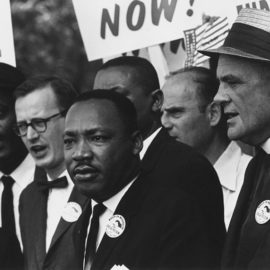

This article is an excerpt from the Shortform book guide to "Liar's Poker" by Michael Lewis. Shortform has the world's best summaries and analyses of books you should be reading.
Like this article? Sign up for a free trial here.
What was Wall Street like in the 1980s? How did the Salomon Brothers make their fortune during this time?
In the 1980s, Wall Street managed to recover from the high unemployment and inflation rates from the previous decade. This led to the rise of the bond market that the Salomon Brothers investment firm took advantage of.
Let’s look at how the Salomon Brothers successfully navigated the bond market during this time.
Wall Street in the 1980s
Before the 1980s, Wall Street was suffering tremendously. The 1970s were a turbulent time of high unemployment and crippling inflation, and in the financial boom that followed, people dove into investing as a means to get rich quickly. This created a fertile hunting ground for unscrupulous traders looking to take advantage of investors. In Liar’s Poker, Michael Lewis discusses the events that led to a boom in the bond market around 1980, how the Salomon Brothers investment firm was ideally poised to make the most of that market, and what the internal culture of Salomon was like.
Lewis traces the roots of Wall Street’s financial trading culture to the Glass-Steagall Act of 1934, which separated investing and commercial banking. A firm could do one or the other, but not both. This created investment banking as its own profession, and investment brokers became the superstars of finance and were often characterized by the scale of their ambitions. For a long time, their profits came from trading stocks, until the practice of charging fixed commissions for each trade was halted in 1975. Stock brokers dropped their rates to undercut each other, and profits bled out of the stock trading business. Traders had to find a new way to make money off of the investors in the market.
(Shortform note: The Glass-Steagall Act, and later the Bank Holding Company Act, were put in place to regulate and stabilize the banking industry after the economic shocks of the Great Depression and World War II. Beginning in 1980, banks successfully pushed for deregulation, culminating in the repeal of the Glass-Steagall Act in 1999. While some experts blame bank deregulation for the economic crash of 2008, others argue that those claims are overstated. During the period about which Lewis writes, economists were mainly concerned with stemming the economic crisis of the 1970s, and they believed that deregulating aspects of the banking system would help the economy correct itself.)
An opportunity appeared in 1979 when the Federal Reserve announced that it would let interest rates fluctuate in an attempt to curb the dollar’s inflation. Lewis says this had an unintended side effect—if interest rates were no longer stable, then bonds would also go up and down in value. Bonds (loans made to governments or corporations) are normally considered a safe, boring, and timid investment compared to more volatile stocks. However, when unmoored from fixed interest rates, bonds suddenly became ripe tools for speculation. Combined with corporate America’s newfound willingness to incur debt as a means to funnel growth, the market for bonds went through the roof, and the firm of Salomon Brothers was positioned to exploit it.
(Shortform note: Financial “speculation” is an investment strategy that couples the possibility of large financial gains with a comparatively large amount of risk. Investors may justify speculation by arguing that the outsized rewards more than balance out any losses they may incur in the process. However, in The Intelligent Investor, Benjamin Graham disparages speculators, saying that they’re overly swayed by impatience and optimism, and that they don’t measure the actual value of whatever stock, bond, or business they’re gambling on.)
Enter: Salomon Brothers
Originally founded as a private partnership, Salomon Brothers became a publicly traded corporation in the ’70s before being acquired by Phibro in 1981, with chairman John Gutfreund personally making $40 million on the deal. Lewis writes that Salomon Brothers’ profits weren’t as important to Gutfreund as the power and prestige he received as CEO. Under Gutfreund’s leadership (or lack thereof) there was absolutely no oversight of what the company’s traders were doing or how they did it. All that mattered was that they made the firm money. Neither was there any sense of moderation from Gutfreund or his fellow executives. According to Lewis, every action they took was either full-throttle or nothing at all.
At the start of the ’80s, the all-or-nothing approach paid dividends, because when the bond market began to take off, Salomon Brothers had already fought for a controlling monopoly of bond trades on Wall Street. They’d been allowed to do so because other trading firms had always disparaged bonds as second-class investments. Once the tide turned, Salomon cornered the market, and its dealers encouraged all of their clients to leverage debt in the form of more bonds, which they’d trade from investor to investor while charging a fee on every transaction. Bond traders used every sales trick in the book to hike up the number of transactions their clients made, always increasing Salomon’s cut of the pie.
Salomon’s bond traders saw themselves as financial entrepreneurs and viewed everyone else in the banking world as timid, cowardly sheep. The trading floor was very much a boys’ club. Women were allowed to sell products to clients, but only men were allowed to join the upper echelons where trading took place. Lewis recounts that bond traders constantly fought to prove their alpha-male status by aggressive trading, excessive self-indulgence, and elaborate pranks that bordered on abuse. Their chief entertainment was a game called “Liar’s Poker”—a version of “I Doubt It” played with dollar bills instead of cards. The point of the game was to read other people, call out bluffs, and learn how to lie—all useful skills in the world of high finance.
Lewis’s Front Row Seat
If Lewis’s appraisal of Wall Street seems harsh, it can’t be said that it’s unearned. Lewis’s knowledge of Salomon Brothers comes from firsthand experience. Fresh out of college in the mid-1980s, Lewis joined the Salomon team, was trained in their philosophy of investing, and then became part of its culture.
Lewis writes that along with the stock market, the number of students pursuing economics boomed in the 1980s, despite the fact that—as he would find out—economic theory has nothing to do with the actual work done by investment firms, which focus more on spotting and exploiting opportunities that arise from brief market fluctuations or investor gullibility. His experience applying for jobs in investing also highlights the industry’s hypocrisy, since he learned early on that in order to succeed, he had to pretend that making money didn’t matter. Instead, he had to claim that he was in it for the challenge.
Once Lewis was hired as a Salomon trainee, he was promised a salary twice as large as what his business professors made. The year was 1985, and Salomon Brothers was rapidly expanding to keep up with the increased demand for their services. Though none of their new hires were loyal to the firm, Salomon’s training did everything it could to indoctrinate recruits into the firm’s way of thinking—that trading was a cutthroat business, the best investment traders were tantamount to sharks, and rank and seniority mattered far less than how much money you could bring in for the business.
Lewis explains that the cutthroat trading culture was baked into Salomon Brothers’ training process. Trainees were pitted against each other in competition for prime work assignments. They were all expected to find mentors in the company—who would either abuse them or else ignore them—and to find ways to make themselves attractive to any departmental managers who might hire them. Humiliation was the point of the process, as was teaching new recruits to be aggressive and conniving in how they landed plum positions in the business. Lewis points out that not all the traders were as awful as the overall culture would suggest—just that concepts such as right and wrong were irrelevant on the trading floor.
After training, Lewis was assigned to the London office where the focus was more on customer relationships and less on the dog-eat-dog tactics of New York. Nevertheless, European investors had their own brand of fiscal gullibility that Lewis was expected to exploit—in particular, the belief that the future of individual stocks and bonds could be predicted by mapping their past. By the end of the ’80s, Lewis became disabused of the notion that how much money you make reflects your personal worth. He would leave the business of investing entirely, but only after witnessing some of its most dramatic ups and downs.

———End of Preview———
Like what you just read? Read the rest of the world's best book summary and analysis of Michael Lewis's "Liar's Poker" at Shortform.
Here's what you'll find in our full Liar's Poker summary:
- A first-hand account of the pursuit of ill-gotten riches at the Salomon Brothers
- The boom and burst of the mortgage bond market
- Where there is room for ethics and level-headed investing






